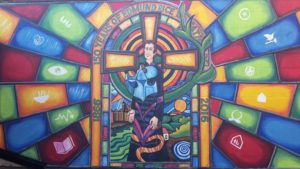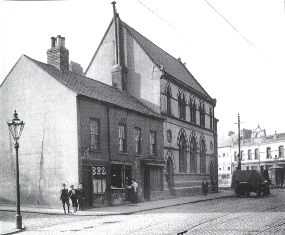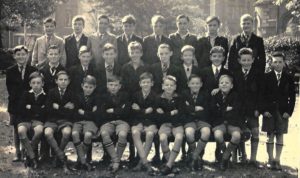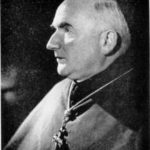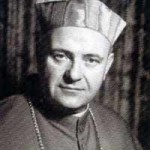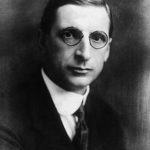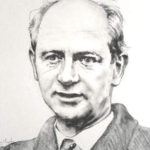CELEBRATING 150 YEARS OF
CHRISTIAN BROTHER / EDMUND RICE EDUCATION
IN BELFAST
12th November 1866 – 12th November 2016
150-years-of-christian-brothers-report
(FLYER cbs-150)
Many thanks to all of you who joined with the Christian Brothers and the Edmund Rice Schools Trust at Mass and/or the Exhibition in celebrating 150 years, to the day, of Christian Brothers /Edmund Rice Education in Belfast.
Many thanks to Bishop Noel Treanor (former pupil of Monaghan CBS) who presided at the Mass,
Bishop Patrick Walsh (former pupil of St Mary’s CBS) who was the main celebrant,
Fr Timothy Bartlett (former pupil of Edmund Rice Primary, Edmund Rice College and St Mary’s CBGS) who gave the homily,
the Parish Priest and Curates of St Mary’s Church, Chapel Lane,
Fr Joe McDonald (former pupil of St Mary’s CBGS and CBS, Glen Road and former Christian Brother),
the students and staff of St Mary’s CBGS who supplied the music for the liturgy
and the students of the five existing Belfast schools who presented the Prayers of the Faithful and the Offertory Gifts at the Mass.
The Brothers began teaching in Belfast on
12th November 1866 in St Mary’s National School on Divis Street (John St).
They have provided education in many
other Belfast schools including:
Former Schools:
St Patrick’s, Donegall St; St Malachy’s, Oxford St;
Hardinge St;
St Mary’s, Divis St; Our Lady of Lourdes, Park Lodge;
Gort na Móna, Dermot Hill;
St Aidan’s Primary, Ballymurphy; and Edmund Rice Primary, Pim St.
Present Schools (Edmund Rice Schools Trust):
Edmund Rice College, Glengormley; CBS, Glen Road;
St Mary’s CBS, Glen Road; St Patrick’s Primary, Antrim Rd;
John Paul II Primary, Ballymurphy;
and Westcourt Centre (Christian Brothers).
IRISH NEWS ARTICLE
A MASS to commemorate the arrival of the Christian Brothers in Belfast 150 years ago has been celebrated in Belfast.
Bishop Noel Treanor presided at the Mass at St Mary’s Church, Chapel Lane and Bishop Patrick Walsh was the main celebrant. The homily was given by the Reverend Tim Bartlett. All three are former pupils of Christian Brothers schools.
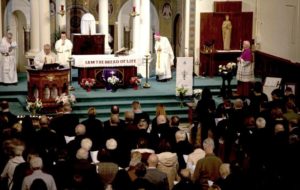 This was followed by a reception and exhibition in the Westcourt Centre, Barrack Street illustrating the contribution of the Christian Brothers and the Edmund Rice Schools Trust to education in Belfast.
This was followed by a reception and exhibition in the Westcourt Centre, Barrack Street illustrating the contribution of the Christian Brothers and the Edmund Rice Schools Trust to education in Belfast.
On November 12 1866, four Christian Brothers arrived in Belfast to begin teaching in St Mary’s in Divis Street. The Brothers had been invited by Dr Patrick Dorrian, Bishop of Down and Connor, to educate the working class and `ragged’ children of this heavily populated area where housing conditions were overcrowded and poverty rife.
They came with a reputation as exceptional teachers who had dedicated their lives to the rule
established by their founder Blessed Edmund Rice. They worked tirelessly with a belief in the transforming and emancipating powers of education. Such was their impact in St Mary’s that they were asked to take on teaching responsibilities in St Patrick’s in Donegall Street, and four more Brothers arrived there on November 27 1867.
A third school, St Malachy’s, was opened in Oxford Street in 1874. The cost of the site and the building, £2,400, was a bequest from a Mrs McGill who wished to have the children of dockers, sailors and those people who worked the barges educated by the Christian Brothers in a location close to the Quays. Oxford Street, as it was commonly referred to, honoured the intentions of its generous benefactor and served that area well.
In 1900, technical education was promoted by the Belfast Corporation and the Brothers successfully applied for funding which they used to establish the Hardinge Street `Trade School’ in 1903. The curriculum that was primarily designed to prepare pupils for careers in industry, engineering and building, included woodwork, metalwork and technical drawing as well as English, mathematics, science, a modern language and religious education. Results were outstanding and in 1915 a first place was achieved in chemistry in an all-Ireland examination and there were state exhibitions in mathematics, science and literature.
These successes in Hardinge Street led to increasing demands for places to the point where enrolment requests were exceeding capacity. Edmund Rice had foresightedly impressed upon his confreres the importance of being prepared for change. Recognising the need for another secondary level school to equip young men for careers in the professions the Brothers opened St Mary’s Grammar School in Barrack Street in 1929.
Once again, increasing demand for places, particularly after the 1947 Education Act, saw the school struggling with accommodation problems. Eventually a large site was acquired close to Airfield House on the Glen Road and a new school building for St Mary’s CBGS opened in 1968 with an intake of 1,320 pupils. The Barrack Street complex continued to be needed and its city centre location made it convenient for younger pupils travelling from other parts of the city and beyond. It continued to be used as a junior school until it finally closed in 1998.
From the 1960s onwards the Brothers opened schools at: St Aidan’s Primary School, Whiterock Road, Edmund Rice Primary School, Pim Street, CBS Secondary School, Glen Road, Edmund Rice College, Hightown Road, Gort na Mona CBS, Dermot Hill, Park Lodge, Antrim Road and the new Edmund Rice Schools Trust schools, John Paul II Primary School, Whiterock Road, St Patrick’s PS, Antrim Road.
In 1999, the Brothers initiated a new project called The Open Doors Learning Centre to meet the needs of young people who, due to their specific circumstances, were not attending mainstream education. With the closure of the junior school at Barrack Street in 1998 and the Open Doors project moved into the building. From 1999-2014 the project helped young people to deal with social, emotional and behavioural problems whilst continuing with a learning plan appropriate to their age and ability.
The premises at Barrack Street have been fully restored and refurbished. It is now called the Westcourt Centre and is supported by the Congregation of Christian Brothers Northern Ireland. Units in the complex provide accommodation for projects whose purpose is primarily educational including the Edmund Rice Schools Trust, The Link Centre Secondary Pupil Support Service, the Belfast Hospital School and the Andersonstown Music School.
Westcourt also runs its own projects providing transformational education along social justice lines. Recent and ongoing work includes parenting support, drugs and alcohol education, suicide awareness training and advocacy initiatives around homelessness as well as providing facilities and meeting space for other charitable and community groups.
The last section of the premises to be refurbished was formally opened and named the Edmund Rice Annex by Brother Edmund Garvey as part of the 150th Anniversary celebrations of the Christian Brothers arrival in Belfast.
************************************************************************************************************************
Centenary of the Arrival of the Brothers in Belfast
1866 – 1966
Rev. Br. J. B. Ledwidge
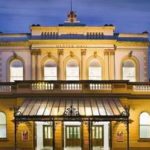 The Centenary Year began with a Monster Rally in the Ulster Hall in November 1965. Speaking to a packed hall, Mr. F. Hanna, LL.B., M.P., recalled the history of the Brothers in Belfast and asked for the support of the parents and the friends of the Brothers, in making the Centenary Year a memorable and successful one. Right Rev. Monsignor P. J. Mullally, Vicar General of the Diocese, seconded and said that no praise was too high for the work of the Brothers.
The Centenary Year began with a Monster Rally in the Ulster Hall in November 1965. Speaking to a packed hall, Mr. F. Hanna, LL.B., M.P., recalled the history of the Brothers in Belfast and asked for the support of the parents and the friends of the Brothers, in making the Centenary Year a memorable and successful one. Right Rev. Monsignor P. J. Mullally, Vicar General of the Diocese, seconded and said that no praise was too high for the work of the Brothers.
The response of the parents and past pupils was overwhelming. Further meetings resulted in the formation of a Central Committee, and a Parents’ Committee in every Brothers’ school in Belfast. A firm of public relations consultants, Irish Public Relations, was employed to coordinate the various efforts.
These Committees worked heroically and with the highest degree of success throughout the year organising events and functions, socials, Christmas fairs, dances, plays and concerts. St. Teresa’s Parents’ Committee, for example, organised a monster bazaar which ran for two nights. St. Aidan’s Parents’ brought the famous Artane Band to the Ulster Hall. Park Lodge Parents and Teachers ran a very highly polished School Concert which delighted capacity audiences.
The Year reached one of its high points; with the New Age of Learning Exhibition organised by the Central Committee which ran for five days in the Ulster Hall. The Exhibition showed the advances made in education during the previous hundred years and included demonstrations by internationally known firms in the field of language laboratories, audio-visual aids, publishing, and electronic equipment. It also had a careers’ advice section and exhibits illustrating how school administration could be efficiently and economically conducted.
Among those who attended the opening ceremony were the Bishop of Down and Connor, the Most Rev. Dr. Philbin; Mr. J. M. Benn, permanent secretary to the Minister of Education; and Mr. W. C. H. Eakin, Belfast Director of Education. Almost fifty firms took part and it was the best attended exhibition held in Belfast for several years.
As the year advanced the parents’ committees continued to organise many and varied functions. St. Malachy’s, Oxford Street, organised a series of pleasant entertainments which were most successful. St. Mary’s Parents’ Committee held an Art Exhibition for which the paintings were donated by prominent artists, the proceeds going to the Centenary Fund.
The spiritual climax of the year came on Whit Sunday, 1966. Over ten thousand people assembled in brilliant
sunshine for an open-air Mass in the grounds of St. Teresa’s Christian Brothers’ School. Present at the Mass was His Eminence Cardinal Conway, together with His Lordship Most Rev. Dr. Philbin, Bishop of the diocese and members of the diocesan chapter.
During the Mass Father Gerard McNamara, PP., spoke warmly of the Brothers’ work in Belfast during the century. “With the coming of the Brothers”, he said, “there began a century of educational dedication unsurpassed in the annals of any diocese. The Brothers for most of that century had worked among the poor ensuring that there would be ‘ education for all’, long before politicians thought of that as a slogan. It was not too much to say of the Brothers what was said of Christ’s first apostles, that ‘ their voice had gone forth into every land even to the ends of the earth ‘ “. Speaking at the dinner afterwards, Cardinal Conway said that iri the previous hundred
years, tens of thousands of boys had passed through the schools of the Brothers in Belfast. There they received a first class education, a capacity for hard work and a strict training of character. Above all they had infused into them a true sense of Christian values, and a deep loyalty to Catholic principles. As a past pupil of the Christian Brothers in Belfast, His Eminence said he could testify to their great dedication to the interests of the boys in their charge. On behalf of himself and the community generally he thanked the Brothers for the enormous services they had given and were still giving.
Dr. Philbin, Bishop of Down and Connor, also expressed his thanks to the Brothers for their great work for education and the splendid influence they had exercised on generations of Catholics in the city. That was open for all to see in the condition of religion here. “The wealth of the Catholic Church”, he declared, “consists in congregations like the Christian Brothers. Their lives are a constant and evident miracle for those who have eyes to see. It is on occasions like this that we should give thanks to the Brothers for the work they are doing, and also give thanks to God who has inspired and strengthened them to carry out their vocation “.
In October 1966 the pupils of the Belfast Schools celebrated the Centenary by producing the School’s Centenary Concert in St. Mary’s Hall. Performers from each School contributed to a feast of music, dancing, acting, mime and gymnastics, which filled the hall to overflowing for three nights. The Centenary Year was now drawing to a close. As a token of thanks to the parents for all they had done, St. Patrick’s, Donegall Street, organised a supper, cabaret and dance. Over five hundred parents had a very enjoyable evening.
The actual centenary of the coming of the Brothers to Belfast occurred on November 3rd 1966. Solemn High Mass was celebrated in St. Peter’s Pro-Cathedral that morning, at which His Lordship Most Rev. Dr. Philbin presided. Also in the Sanctuary was Most Rev. Dr. Eugene Butler, Bishop of Mombasa, who was educated in St. Mary’s Grammar School.
Father Michael Kelly, P.P., also a former pupil of St. Mary’s, said in his sermon “The Brothers came to Belfast because they believed vehemently in those principles which the Fathers of the Vatican Council have so recently affirmed: that all men of every race, condition and age, since they enjoy the dignity of human beings, have an unalienable right to an education that is in keeping with their ultimate destiny.
As the Council Fathers, a century later, were to ‘ entreat most earnestly that a special concern should be shown to the needs of those who are poor in the goods of this world ‘, the pioneer Brothers early displayed that concern by the very areas in which they had their first schools: St. Mary’s in Divis Street, to cater for the children of the mills of the Falls; St. Patrick’s in Donegall Street to serve the children of the docks, and St. Malachy’s in Oxford Street to serve the children of the Markets. We have come here to offer together the Holy Sacrifice of the Mass in thanksgiving to God for the graces and blessings of the last hundred years, and it is fitting that on the feast-day of the patron of the diocese, in the presence of the Bishop of the diocese, in the presence of the priests and religious of the diocese and in the presence of so many of the laity of the diocese, a public acknowledgment of gratitude should be made to the Brothers for the good they have done in this city over the past century. In particular, their achievement in the field of secondary education, before the major reorganisation of the nineteen forties for a section of the community who otherwise could not have obtained such an education, has been truly immense… If to-day they taught in buildings that were much more spacious than those provided for Br. Caton and his companions, if their equipment and amenities were much more adequate, and if the home circumstances of many of their pupils were much less strained, they knew that the same personal and painstaking care was bestowed on each pupil, the same spirit animated their schools, the same religious formation was fostered, the same self-sacrifice was evident in their personal lives. They enjoyed to-day as in the past, the same loyal co-operation from their lay teachers, worthy successors of those dedicated figures many of whose names were revered in this city.
There have been hardships and disappointments, ingratitude and discouragement, periods of distrust and misunderstanding. To-day five thousand boys in their seven schools are reaping the reward and are the fruit of those early trials and crosses. The Christian Brothers have a proud record in this city. They have to-day an honoured place in the educational arrangements of this city and diocese, and they have a treasured place in the affections of the priests and people alike. As we look back, in thanksgiving to God, over the century since Br. Caton and his companions first came amongst us, surely it is appropriate that, in the words of the Vatican Council, we should acknowledge our profound gratitude to these religious men and their lay teachers who have devoted themselves to this noble work of education in our midst, and looking out over the years ahead, let us, again in the words of the Council, exhort them to persevere generously in their chosen task, striving to excel in penetrating their students with the spirit of Christ, in the art of teaching and in the advancement of knowledge.”
On the evening of November 3rd the Centenary Dinner was held in the Banqueting Hall at Balmoral. There were four hundred guests present, including Cardinal Conway, Most Rev. Dr. Philbin, Very Rev. Bro. A. A. Loftus, Superior General of the Christian Brothers and Sir Tyrone Guthrie, Chancellor of Queen’s University.
During the evening Mr. Brendan Harkin, President of the Past Pupils’ Union and Chairman of the Centenary Committee, presented Bro. Loftus with a cheque for £40,000, which he said was “On account” and was £10,000 more than the target they had set themselves. Continuing, Mr. Harkin said that the prime purpose of the centenary functions was to express the gratitude of their past pupils in Belfast to all Christian Brothers and in particular to those in the city. “They found us on our knees and they raised us to the stature of men”, said Mr. Harkin. He praised the parents’ committees of the schools, which he said, had taken the full brunt of the work of raising funds. As Christians, they must be prepared to play their part to remove the divisions in their community in the North, and while there were wide gulfs between them in certain areas there were also wide areas on which they could reach agreement. He hoped, he said, that their parents’ committees would blossom forth into parents’ associations, and he thought it was regrettable that they did not have parents’ associations attached to their Catholic schools. He hoped that if they were formed they would affiliate to existing bodies in the community and get to know other parents from other denominations and so help children from all sections of the community to get to know each other better.
The Superior General, Very Rev. Bro. A. A. Loftus, spoke of the debt of gratitude the Brothers owed to the people of Belfast for their support, both financial and moral, through their long stay in the city. He spoke of the growth of the Congregation throughout the world and he expressed to the Belfast past pupils his warm thanks for presenting him that morning with a cheque towards the education of the first negro Brother in Africa.
Cardinal Conway spoke of happy memories of his stay with the Christian Brothers in Belfast and of how deeply he had been moved by their life of dedication and their high sense of self-effacement.
The dinner marked the official ending of the Centenary Year, a year revealing, as the Golden Jubilee Year had done, the extraordinary generosity, loyalty and enthusiasm of the Catholic people of Belfast to the Brothers who have had the privilege of living among them during this first hundred years.
Since the establishment of the first Irish government in 1922 all the Irish Prime Ministers (Taoisigh)
have been past pupils of the Christian Brothers:
1922: Mr. Arthur Griffith, Sinn Fein (Gt. Strand St., Dublin)
1922-1932: Mr. William T. Cosgrave, Cumann na nGael (C.B.S. James’s Street and O’Brien Institute, Dublin)
1932-1948; 1951-1954; 1957-1959: Mr. Eamon De Valera, Fianna Fail (C.B.S., Rathluirc)
1948-1951; 1954-1957: Mr. John A. Costello, Fine Gael (O’Connell School, Dublin)
1959-1966: Mr. Sean Lemass, Fianna Fail (O’Connell School)
1966-: Mr. Jack Lynch, Fianna Fáil (North Monastery, Cork)
So also are the present leaders of the opposition parties:
Mr. Liam Cosgrave, Fine Gael (C.B.S., Synge Street, Dublin) and
Mr. Brendan Corish, Labour (C.B.S., Wexford)
